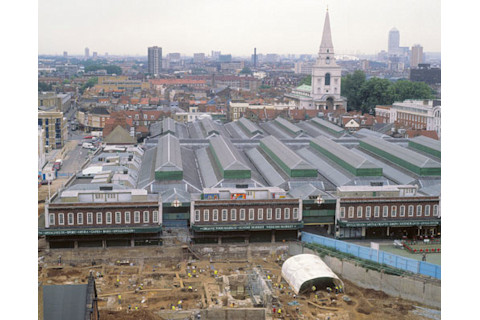
The excavation at Spitalfields
The churchyard at St. Mary's in Spitalfields, London, was the final resting place for more than 10,000 people in medieval times. But among the run-of-the-mill gravesites, archaeologists with the Museum of London Archaeology have found
, were 175 mass graves, containing the closely packed bodies of thousands of men, women, and children. What happened to these people? The answer, it turns out, could be decidedly unusual. The team's first thought was the obvious: the Black Death, which ravaged England starting in 1347. But once the bodies in the mass graves were carbon dated, it was clear that they had died a hundred years before the first plague-carrying flea came to Britain: around 1250. "As soon as we got the radiocarbon dates back, we knew that couldn't possibly be the case. There had to be some other event," says Natasha Powers, the head of osteology at the Museum of London Archaeology. Sifting through documents from the 1250s, they found references to catastrophic famines in 1257-58, caused by unusually dark, cold, and dry weather: "In this year, there was a failure of the crops; upon which failure, a famine ensued, to such a degree that the people from the villages resorted to the City for food; and there, upon the famine waxing still greater, many thousand persons perished," wrote the sheriffs of London in 1257
. And indeed, when the team looked at who was buried in the mass graves, they saw an unusually high number of young people and signs of two waves of mass burials, just the kind of signs you would expect from a serious, multi-year famine.

An archaeologist works in one of the mass graves.
But there's more: while learning about the famines, the team happened across a paper that linked the disastrous weather of those years with an immense volcanic eruption
, the worst in the past thousand years, whose chemical signatures were visible in ice cores from glaciers in both hemispheres. The eruption, dated to around 1258, would have filled the atmosphere not only with dust and ash, but also sulfur compounds that decrease rainfall and alter weather. The team believes it's likely that could have led to the deaths of the thousands of Londoners in the Spitalfields mass graves. There's one more postscript to this odd story: No one knows, yet, exactly where this volcano was. All we have are the fingerprints it left in the dust that rained down onto glaciers after it blew its top. The best guesses so far are either somewhere in Central or South America, or, according a paper published this year
, Indonesia. At least 7,000 miles separate each of these places from London, a reminder of how interconnected even distant places can be when the atmosphere is involved.
Images courtesy of MOLA













